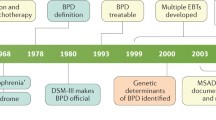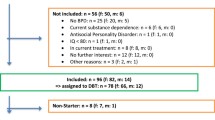Summary
Patients with Borderline Personality Disorder (BPD) show a pervasive pattern of instability in their affects, impulsivity, self-image as well as in their interpersonal relationships.
Co-morbid mental disorders, particularly disorders like depression, anxiety and substance-related disorders are common. The high amount of health care utilization of borderline-patients makes care systems encounter considerable challenges. Although disorder-specific psychotherapeutic concepts of treatment have proven efficacious, it needs to be emphasized that the current range of outpatient care available for borderline-patients in Germany and in Austria is absolutely insufficient. The major part of the high costs of inpatient care could certainly be reduced by establishing an integrated care system.
In the current follow-up survey 73 patients were contacted who – being diagnosed with Borderline Personality Disorder according to DSM-IV – had at least one inpatient stay in department 5B, the department of cognitive behavioural treatment, in the Vienna General Hospital (AKH) in the years from 2000 to 2004. Questionnaires provided information on socio-demographic data, on the extent of medical and psychotherapeutic treatment, the severity of symptoms (BSL) and on the quality of life (WHOQOL-BREF). 29 patients were reached after an average period of 2.2 (SD+/- 1.3) years following the inpatient stay in the department of cognitive behavioural treatment (Response rate 39.7%). At the time of the survey 22 persons (75.9 %) received psychotherapy, 18 persons (62.1 %) regularly consulted a psychiatrist, 13 persons were in regular contact with a general practitioner (45 %).
The subjective severity of symptoms according to the Border-line Symptom List (BSL) turns out below average with a percentage value of 19. This means 81% of the norm sample of 308 female patients with BPD shows a higher severity of symptoms than the patient population surveyed.
However, the quality of life in WHOQOL-BREF turns out to be significantly (p < 0.01) reduced. Apart from the evaluation of the severity of total symptomatology, there was a 5-step Likert scale (BSL-SUPPLEMENTARY SCALE) administered to assess the borderline specific dysfunctional behaviour; the period selected for evaluation was the past week regarding to follow up. Results of the BSL-SUPPLEMENTARY SCALE demonstrate a high range and various aspects of borderline typical complaints, concerning self injury, like attempted suicide, addiction to certain substances, drug or alcohol abuse, eating disorder and uncritical sexual contacts, followed by regret. This outcome reflects the main problem dealing with the transfer of the therapeutically induced change of behaviour during the inpatient stay into the outpatient daily life experience.
The low response rate of 39.7 % in this follow-up survey also reflects the compliance problems of these patients with regard to psychiatric treatment.
Zusammenfassung
Patienten mit einer Borderline-Störung (BPS) zeigen ein tiefgreifendes Muster von Instabilität in der Affektregulation, Impulskontrolle, Selbstwertregulation sowie im interpersonellen Bereich.
Komorbide psychische Erkrankungen, insbesondere depressive Störungen, Angststörungen und substanzbezogene Störungen, sind häufig. Das starke Inanspruchnahmeverhalten von Borderline-Patienten fordert die Versorgungsstrukturen in hohem Ausmaß. Obwohl sich störungsspezifische psychotherapeutische Behandlungskonzepte als wirksam erwiesen haben, muss betont werden, dass die gegenwärtige Versorgungssituation für Borderline-Patienten in Deutschland und in Österreich im ambulanten Bereich völlig unzureichend ist. Der Großteil der hohen stationären Kosten könnte durch den Aufbau einer integrierten Versorgung sicherlich reduziert werden.
Im Rahmen der vorliegenden Nachuntersuchung wurden 73 Patienten, die im Zeitraum von 2000–2004 zumindest einmal stationär an der verhaltenstherapeutischen Station 5B im AKH-Wien mit der Diagnose Borderline-Störung nach DSMIV aufgenommen waren, angeschrieben. Mittels Fragebögen wurden soziodemographische Daten, das Ausmaß der medikamentösen und psychotherapeutischen Behandlung, die Symptombelastung (BSL) und die Lebensqualität (WHOQOL- BREF) erhoben. Durchschnittlich 2,2 (SD ± 1,3) Jahre nach dem stationären Aufenthalt an der verhaltenstherapeutischen Station an der Universitätsklinik für Psychiatrie konnten 29 Patienten (Responserate 39,7 %) erreicht werden. Zum Befragungszeitpunkt waren 22 (75,9 %) der untersuchten Personen in psychotherapeutischer Behandlung, von einem Facharzt für Psychiatrie wurden 18 (62,1 %) Personen regelmäßig betreut, 13 Personen kontaktierten regelmäßig einen praktischen Arzt (45 %). Die subjektive Symptombelastung, welche mittels der Borderline-Symptom-Liste (BSL) erhoben wurde, zeigte mit einem Prozentrang von 19 einen unterdurchschnittlichen Wert. Somit weisen 81 % der zu vergleichenden Normstichprobe mit BPS eine höhere Symptombelastung auf als das untersuchte Patientenkollektiv; dennoch ist die Lebensqualität im WHOQOL-BREF signifikant (p < 0,01) reduziert. Es wurde, abgesehen von der Evaluierung des Schweregrades der Gesamtsymptomatik, zur quantitativen Erfassung von borderlinespezifischer Problematik auf der Verhaltensebene eine 5-stufige Likert-Skala (BSL-ERGÄNZUNGSSKALA) zur retrospektiven Selbsteinschätzung dysfunktionalen Verhaltens, die letzten 7 Tage vor dem Nachuntersuchungszeitpunkt betreffend, vorgegeben. Die Ergebnisse der BSL-ERGÄNZUNGSSKALA weisen auf einen hohen Störungsgrad hin und belegen zahlreiche selbstschädigende Verhaltensweisen wie Suizidversuche, Substanzabusus, Essstörung und unkritische Sexualkontakte, womit das Problem des Transfers von im stationären Setting erreichter Verhaltensänderung in das alltägliche Funktionieren evident wird. Die niedrige Rücklaufrate von 39,7 % im Rahmen dieser Nachuntersuchung steht auch für die Compliance-Probleme dieser Patienten psychiatrische Behandlung betreffend.
Similar content being viewed by others
Literatur
Grant BF, Chou SP, Goldstein RB et al. Prevalence, correlates, disability and comorbidity of DSM-IV borderline personality disorder. Results from the wave 2 national epidemiologic survey on alcohol and related conditions. J Clin Psychiatry 69, 4: 533-545, 2008.
Coid J, Yang M and Tyrer P et la. (2006). Prevalence and correlates of personality disorder in Great Britain. Br J Psychiatry 188: 423–431
Bohus M, Lieb K. Borderline – Persönlichkeitsstörung (ICD-10 F6). In: Voderholzer U, Hohagen F (Hrsg) Therapie psychischer Erkrankungen, State of the Art 2008, 2009, 4. Auflage, München, Elsevier GmbH, Urban & Fischer, pp 346-358, 2009.
Bohus M and Schmahl C. (2007). Psychopathologie und Therapie der Borderline Störung. Nervenarzt 78: 1069–1081
Bohus M, Lieb K. Borderline – Persönlichkeitsstörung (ICD-10 F6). In: Voderholzer U, Hohagen F (Hrsg) Therapie psychischer Erkrankungen, State of the Art 2006, 2007, 2. Auflage, München, Jena, Elsevier GmbH, Urban & Fischer, 2007.
Bohus M and Höschel K. (2006). Psychopathologie und Behandlung der Borderline Persönlichkeitsstörung. Psychotherapeut 51: 261–270
Widiger TA and Weissman MM. (1991). Epidemiology of borderline personality disorder. Hospital and Community Psychiatry 42: 1015–1021
Zanarini MC, Frankenburg FR and Khera GS et al. (2001). Treatment histories of borderline inpatients. Comprehensive Psychiatry 42: 144–150
Bender DS, Dolan RT and Skodol AE et al. (2001). Treatment utilization by patients with personality disorders. Am J Psychiatry 158: 295–302
Bohus M. Zur Versorgungssituation von Borderline-Patienten in Deutschland. Persönlichkeitsstörungen – Theorie und Therapie, 11: 149-153, 2007.
Zanarini MC, Frankenburg FR and Hennen J et al. (2006). Prediction of the 10-year course of borderline personality disorder. Am J Psychiatry 163: 827–832
Zanarini MC, Frankenburg FR and Hennen J et al. (2003). The longitudinal course of borderline psychopathology: 6-year prospective follow-up of the phenomenology of borderline personality disorder. Am J Psychiatry 160: 274–283
Bateman AW and Fonagy P. (2001). Treatment of borderline personality disorder with psychoanalytically oriented partial hospitalization: An 18-month follow-up. Am J Psychiatry 158: 36–42
Bateman AW, Fonagy P. 8-year follow-up of patients treated for borderline personality disorder: mentalization-based treatment versus treatment as usual. Am J Psychiatry 165: 631-638, 2008.
Rüesch P, Neuenschwander M. Soziale Netzwerke und soziale Unterstützung. In: Rössler W (Hrsg) Psychiatrische Rehabilitation. Berlin, Heidelberg, New York, Springer-Verlag, pp 7-20, 2004.
Jerschke S, Meixner K and Richter H et al. (1998). Zur Behandlungsgeschichte und Versorgungssituation von Patientinnen mit Borderline-Persönlichkeitsstörung in der Bundesrepublik Deutschland. Fortschr Neurol Psychiat 66: 545–552
Nosiska D, Riklin S and Lenz G. (2006). Psychosoziale Situation von Patienten mit Borderline Persönlichkeitsstörung: Betreuungssituation, Lebensqualität und Symptombelastung. Gemeindenahe Psychiatrie 27: 7–27
Kellogg SH and Young JE. (2006). Schema therapy for borderline personality disorder. J Clin Psychol 62: 445–458
Giesen-Bloo J, Spinhoven P and Dyck R et al. (2006). Outpatient psychotherapy for borderline personality disorder: randomized trial of schema- focused therapy vs transference-focused Psychotherapy. Arch Gen Psychiatry 63: 649–658
Angermeyer MC, Kilian R, Matschinger H. WHOQOL-100 und WHOQOL-BREF. Handbuch für die deutschsprachige Version der WHO-Instrumente zur Erfassung von Lebensqualität. Göttingen, Hogrefe, 2000.
Bohus M, Limberger MF and Frank U et al. (2001). Entwicklung der Borderline- Symptom-Liste. Psychother Psychosom Med Psychol 51: 201–211
Linehan MM, Comtois KA and Murray AM et al. (2006). Two-year randomized controlled trial and follow-up of dialectical behaviour therapy vs. therapy by experts for suicidal behaviours and borderline personality disorder. Arch Gen Psychiatry 63: 757–766
Clarkin J, Levy K and Lenzenweger M et al. (2007). Evaluating three treatments for borderline personality disorder – A multiwave study. Am J Psychiatry 164: 922–928
Stelzig-Schöler R, Keglevic M and Haberfellner E M. (2009). Psychiatrische Rehabilitation in Österreich. Psychiatr Psychother 4: 10–16
Kunze H, Pohl J. Leitlinien zur Rehabilitation und Integration. In: Schmidt-Zadel R, Pörksen N, Aktion Psychisch Kranke (Hrsg) Teilhabe am Arbeitsleben – Arbeit und Beschäftigung mit psychischen Beeinträchtigungen. Bonn, Psychiatrie-Verlag, 2003.
Gardowsky P. Leistungsrecht in Österreich. In: Rössler W (Hrsg) Psychiatrische Rehabilitation. Berlin, Heidelberg, New York, Springer- Verlag, pp 729-750, 2004.
Author information
Authors and Affiliations
Corresponding author
Additional information
Psychosocial situation of patients with borderline personality disorder: care and support, quality of life and severity of symptoms after inpatient treatment
Eingelangt am 12. September 2009, angenommen am 7. Dezember 2009
Rights and permissions
About this article
Cite this article
Nosiska, D., Ponocny-Seliger, E., Hauska, S. et al. Psychosoziale Situation von Patienten mit Borderline- Persönlichkeitsstörung: Betreuungssituation, Lebensqualität und Symptombelastung nach einem stationären Aufenthalt. psychiatr. psychother. 6, 8–20 (2010). https://doi.org/10.1007/s11326-010-0082-0
Published:
Issue Date:
DOI: https://doi.org/10.1007/s11326-010-0082-0




